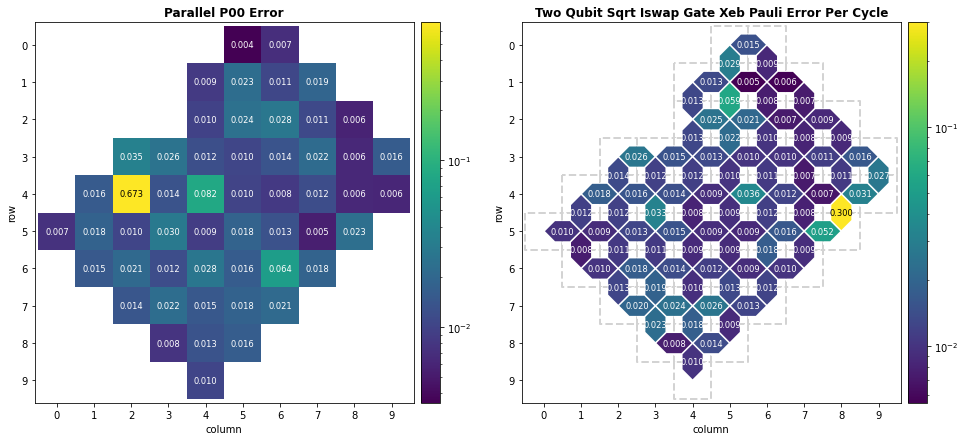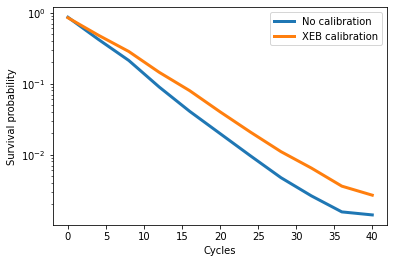 View on QuantumAI View on QuantumAI
|
 Run in Google Colab Run in Google Colab
|
 View source on GitHub View source on GitHub
|
|
This tutorial shows a detailed example and benchmark of Cross-Entropy Benchmarking (XEB) calibration.
Disclaimer: The data shown in this tutorial is exemplary and not representative of the QCS in production.
Setup
try:
import cirq
except ImportError:
!pip install --upgrade --quiet cirq~=1.0.dev
# The Google Cloud Project id to use.
project_id = "" # @param {type:"string"}
processor_id = "" # @param {type:"string"}
from cirq_google.engine.qcs_notebook import get_qcs_objects_for_notebook
device_sampler = get_qcs_objects_for_notebook(project_id, processor_id)
if not device_sampler.signed_in:
raise Exception(
"Please setup project_id in this cell or set the `GOOGLE_CLOUD_PROJECT` env var to your project id."
)
import cirq
from cirq.experiments import random_quantum_circuit_generation as rqcg
import cirq_google as cg
import matplotlib.pyplot as plt
import numpy as np
import tqdm
# @title Helper functions
from typing import Sequence
def create_random_circuit(
qubits: Sequence[cirq.GridQubit],
cycles: int,
twoq_gate: cirq.Gate = cirq.FSimGate(np.pi / 4, 0.0),
seed: int | None = None,
) -> cirq.Circuit:
return rqcg.random_rotations_between_grid_interaction_layers_circuit(
qubits,
depth=cycles,
two_qubit_op_factory=lambda a, b, _: twoq_gate.on(a, b),
pattern=cirq.experiments.GRID_STAGGERED_PATTERN,
single_qubit_gates=[
cirq.PhasedXPowGate(phase_exponent=p, exponent=0.5) for p in np.arange(-1.0, 1.0, 0.25)
],
seed=seed,
)
def create_loschmidt_echo_circuit(
qubits: Sequence[cirq.GridQubit],
cycles: int,
twoq_gate: cirq.Gate = cirq.FSimGate(np.pi / 4, 0.0),
seed: int | None = None,
) -> cirq.Circuit:
"""Returns a Loschmidt echo circuit using a random unitary U.
Args:
qubits: Qubits to use.
cycles: Depth of random rotations in the forward & reverse unitary.
twoq_gate: Two-qubit gate to use.
pause: Optional duration to pause for between U and U^\dagger.
seed: Seed for circuit generation.
"""
forward = create_random_circuit(qubits, cycles, twoq_gate, seed)
return forward + cirq.inverse(forward) + cirq.measure(*qubits, key="z")
def to_ground_state_prob(result: cirq.Result) -> float:
return np.mean(np.sum(result.measurements["z"], axis=1) == 0)
Select qubits
First we select a processor and calibration metric(s) to visualize the latest calibration report.
processor_id = "" # @param {type:"string"}
metrics = "parallel_p00_error, two_qubit_sqrt_iswap_gate_xeb_pauli_error_per_cycle" # @param {type:"string"}
metrics = [m.strip() for m in metrics.split(sep=",")]
from matplotlib.colors import LogNorm
_, axes = plt.subplots(nrows=1, ncols=len(metrics), figsize=(min(16, 8 * len(metrics)), 7))
calibration = cg.get_engine_calibration(processor_id=processor_id)
for i, metric in enumerate(metrics):
calibration.heatmap(metric).plot(
ax=axes[i] if len(metrics) > 1 else axes,
collection_options={"norm": LogNorm()},
annotation_format="0.3f",
annotation_text_kwargs={"size": "small"},
);

Using this report as a guide, we select a good set of qubits.
# Select qubit indices here.
qubit_indices = [(2, 5), (2, 6), (2, 7), (2, 8), (3, 8), (3, 7), (3, 6), (3, 5), (4, 5), (4, 6)]
qubits = [cirq.GridQubit(*idx) for idx in qubit_indices]
An example random circuit on these qubits (used as the forward operations of the Loschmidt echo) is shown below.
create_random_circuit(qubits, cycles=10, seed=1)
Set up XEB calibration
Now we specify the cycle depths and other options for XEB calibration below. Note that all cirq.FSimGate parameters are characterized by default.
xeb_options = cg.LocalXEBPhasedFSimCalibrationOptions(
cycle_depths=(5, 25, 50, 100),
n_processes=1,
fsim_options=cirq.experiments.XEBPhasedFSimCharacterizationOptions(
characterize_theta=False,
characterize_zeta=True,
characterize_chi=True,
characterize_gamma=True,
characterize_phi=False,
),
)
Run a Loschmidt echo benchmark
"""Setup the Loschmidt echo experiment."""
cycle_values = range(0, 40 + 1, 4)
nreps = 20_000
trials = 10
sampler = cg.get_engine_sampler(
project_id=project_id, processor_id=processor_id, gate_set_name="sqrt_iswap"
)
loschmidt_echo_batch = [
create_loschmidt_echo_circuit(qubits, cycles=c, seed=trial)
for trial in range(trials)
for c in cycle_values
]
Without calibration
First we run the Loschmidt echo without calibration.
# Run on the engine.
raw_results = sampler.run_batch(programs=loschmidt_echo_batch, repetitions=nreps)
# Convert measurements to survival probabilities.
raw_probs = np.array([to_ground_state_prob(*res) for res in raw_results]).reshape(
trials, len(cycle_values)
)
With XEB calibration
Now we perform XEB calibration.
# Get characterization requests.
characterization_requests = cg.prepare_characterization_for_operations(
loschmidt_echo_batch, xeb_options
)
# Characterize the requests on the engine.
characterizations = cg.run_calibrations(characterization_requests, sampler)
# Make compensations to circuits in the Loschmidt echo batch.
xeb_calibrated_batch = [
cg.make_zeta_chi_gamma_compensation_for_moments(circuit, characterizations).circuit
for circuit in loschmidt_echo_batch
]
100%|██████████| 45/45 [00:46<00:00, 1.04s/it] 100%|██████████| 45/45 [01:50<00:00, 2.45s/it] 100%|██████████| 45/45 [01:00<00:00, 1.34s/it] 100%|██████████| 45/45 [02:24<00:00, 3.20s/it]
And run the XEB calibrated batch below.
# Run on the engine.
xeb_results = sampler.run_batch(programs=xeb_calibrated_batch, repetitions=nreps)
# Convert measurements to survival probabilities.
xeb_probs = np.array([to_ground_state_prob(*res) for res in xeb_results]).reshape(
trials, len(cycle_values)
)
Compare results
The next cell plots the results.
plt.semilogy(cycle_values, np.average(raw_probs, axis=0), lw=3, label="No calibration")
plt.semilogy(cycle_values, np.average(xeb_probs, axis=0), lw=3, label="XEB calibration")
plt.xlabel("Cycles")
plt.ylabel("Survival probability")
plt.legend();

A smaller (in magnitude) slope indicates lower two-qubit gate errors. You should see that XEB calibration produces lower errors than no calibration in the Loschmidt echo benchmark.
